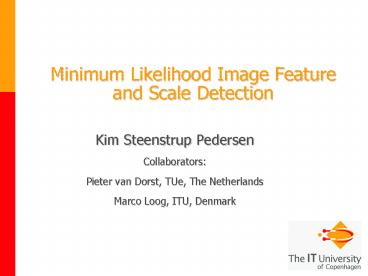Minimum Likelihood Image Feature and Scale Detection PowerPoint PPT Presentation
1 / 17
Title: Minimum Likelihood Image Feature and Scale Detection
1
Minimum Likelihood Image Feature and Scale
Detection
- Kim Steenstrup Pedersen
- Collaborators
- Pieter van Dorst, TUe, The Netherlands
- Marco Loog, ITU, Denmark
2
What is an image feature?
- Marrs (1982) primal sketch (edges, bars,
corners, blobs) - Geometrical features, Marrs features defined by
differential geometry Canny (1986),
Lindeberg (1998) - Iconic features Koenderink (1993), Griffin
Lillholm (2005)
Observation Features are usually points and
curves, i.e. sparsely distributed in space
(unlikely events). Features have an intrinsic
scale / size. How blurred is the edge?What is
the size if a bar?
3
A probabilistic primal sketch
- Our definition Features are points that are
unlikely to occure under an image model.
Similarly the scale of the feature is defined as
the most unlikely scale. - We use fractional Brownian images as a generic
model of the intensity correlation found in
natural images. Captures second order statistics
of generic image points (non-feature points). - The model includes feature scale naturally.
- This leads to a probabilistic feature and scale
detection. - Possible applications Feature detection,
interest points for object recognition,
correspondance in stereo, tracking, etc.
4
Probabilistic feature detection
- Feature detection
- Konishi et al. (1999, 2002, 2003)
- Lillholm Pedersen (2004)
- Scale selection
- Pedersen Nielsen (1999)
- Loog et al. (2005)
5
Linear scale-space derivatives
- Scale-space derivatives
6
Scale Space k-Jet Representation
- We use the k-jet as representationof the local
geometry - (The coefficients of the truncatedTaylor
expansion of the blurredimage.) - Biologically plausiblerepresentation
(Koenderink et al., 1987)
7
Probabilistic image models
- Key results on natural image statistics
- Scale invariance / Self-similarity Power
spectrum, Field (1987),
Ruderman Bialek (1994) - In general non-Gaussian filter responses!
- Fractional Brownian images as model of natural
images - Mumford Gidas (2001), Pedersen (2003),
Markussen et al. (2005) - Jet covariance of natural images resembles that
of fractional Brownian images Pedersen (2003)
8
Fractional Brownian images
9
FBm in Jet space
- (Result from Pedersen (2003))
10
Detecting Features and Scales
- Detecting points in scale-space that are locally
unlikely (minima) - (We could also have maximised .)
11
Why minimum likeli scales?
- Lindeberg (1998) maximises polynomials of
derivatives in order to detect features and
scales. - Similarly, we maximise in order to detect
features and scales. - The difference lies in the choice of polynomial!
We use an image model and Lindeberg uses a
feature model.
12
Synthetic examples Double blobs
13
Synthetic examples Blurred step edge
14
Real Example Sunflowers
15
Sunflowers Multi-scale
16
Sunflowers Fixed scale
17
Summary
- Minimising the likelihood of an image point
under the fractional Brownian image model detects
feature points and their intrinsic scale. - There is a relationship between feature types
and the ? parameter. - Why over estimation of the scale?
- Preliminary results look promising, a
performance evaluation is needed (task based?). - The method is pointwise. How to handle curve
features (edges, bars, ridges)?

